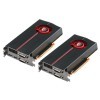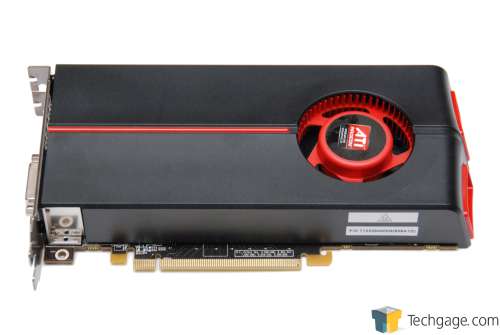- Qualcomm Launches Snapdragon 4 Gen 2 Mobile Platform
- AMD Launches Ryzen PRO 7000 Series Mobile & Desktop Platform
- Intel Launches Sleek Single-Slot Arc Pro A60 Workstation Graphics Card
- NVIDIA Announces Latest Ada Lovelace Additions: GeForce RTX 4060 Ti & RTX 4060
- Maxon Redshift With AMD Radeon GPU Rendering Support Now Available
ATI Radeon HD 5770 CrossFireX Performance

Want to purchase a Radeon HD 5870, but can’t find one in stock? One alternative to consider is instead purchasing two Radeon HD 5770’s to take advantage of CrossFireX. Not only does this solution save you up to $80 at current pricing, but it proved in our results to offer even better performance in select titles, such as with Modern Warfare 2.
Page 1 – Introduction
This past October, AMD released the first follow-up cards to its Radeon HD 5000 launch models, the HD 5770 and HD 5750. As mid-range offerings, these cards came at a perfect time… mere weeks after the initial launch. While the HD 5870 and HD 5850 are without question the best performing cards on the market right now, not everyone wants to separate themselves from $300 – $400, so the $109 and $159 price tags of these new cards appealed to a much greater audience.
As we discovered in our original review of the HD 5770 card, there’s a lot to love here. Performance-wise, the card comes close to the performance of the HD 4870, which retailed for more than twice as much at its launch. But here, we have some notable additions, such as far improved power efficiency and lower temperatures, and of course new technologies like DirectX 11 and Eyefinity. In the end, although the HD 5770 performed a bit slower than the HD 4870, the perks outweighed that lone downside.
If there’s a major downside plaguing the HD 5000 series right now, it’s the obvious lack of availability. Since the HD 5870 and HD 5850 launched, it’s been a real chore for anyone who wants one to be able to purchase one. More often than not, the most popular e-tailers out there are out of stock, which is unfortunate. It’s one thing release a product that blows people’s minds, but it’s another to actually allow the same people the ability to purchase them.
As odd as it may be, both the HD 5750 and HD 5770 seem to be exempt from this issue, and since their launch, I haven’t ever seen the cards out of stock. There are rumors that AMD and TSMC is having issues with the reliability of producing certain 40nm chips, and since we’re seeing constant availability of the mid-range cards, it seems reasonable to believe that. After all, you’d imagine that yields when producing a ~1.04 million transistor chip would be better than producing chips with ~2.15 million.
Whatever the issue, the lack of HD 5850 and HD 5870 cards raises an interesting question. Because there’s ample supply of the HD 5770 cards, what about taking the CrossFireX route over holding out for the single-GPU HD 5870? If this configuration could even come close to the performance of an HD 5870, then it might actually work out better for gamers, since 2 x HD 5770 costs around ~$320, while a single HD 5870 is ~$400.
As we published a proper review of the Radeon HD 5770 two months ago, I’m not going to rehash everything that was said there, but if you are curious to learn a bit more, I recommend checking back to that article, and page two in particular. There, we point out the differences between the HD 5870 and HD 5770, and for the most part, one is double the other. The primary difference is the slimmer memory bus, down to 128-bit from 256-bit. If there’s one thing to keep our CrossFireX configuration of two HD 5770’s from matching the HD 5870, that’d be it.
|
Model
|
Core MHz
|
Mem MHz
|
Memory
|
Bus Width
|
Processors
|
| Radeon HD 5970 |
725
|
1000
|
2048MB
|
256-bit
|
1600 x 2
|
| Radeon HD 5870 |
850
|
1200
|
1024MB
|
256-bit
|
1600
|
| Radeon HD 5850 |
725
|
1000
|
1024MB
|
256-bit
|
1440
|
| Radeon HD 5770 |
850
|
1200
|
1024MB
|
128-bit
|
800
|
| Radeon HD 5750 |
700
|
1150
|
512 – 1024MB
|
128-bit
|
720
|
| Radeon HD 4890 |
850 – 900
|
975
|
1024MB
|
256-bit
|
800
|
| Radeon HD 4870 |
750
|
900
|
512 – 2048MB
|
256-bit
|
800
|
| Radeon HD 4850 |
625
|
993
|
512 – 1024MB
|
256-bit
|
800
|
| Radeon HD 4770 |
750
|
800
|
512MB
|
128-bit
|
640
|
| Radeon HD 4670 |
750
|
900 – 1100
|
512 – 1024MB
|
128-bit
|
320
|
| Radeon HD 4650 |
600
|
400 – 500
|
512 – 1024MB
|
128-bit
|
320
|
For cards priced at ~$130 and higher, I personally think it’d be foolish to pick up an HD 4000 series card right now, unless you’re able to get one at a great price. Some people don’t weigh the perks quite as heavily as I do, and that’s fine, but I am constantly impressed by the strides AMD made with its latest series. The power consumption is much improved, and so is the temperatures, and as mentioned above, there’s things like DirectX 11 that will prove more important as time goes on.
Before we dive into a look at our performance results, I should mention two potential downsides of going with a CrossFireX configuration over the single HD 5870. Because we’re using two cards, the power consumption is naturally going to be higher, but it’s not near as stark as you’d imagine, since as mentioned before, the HD 5870 is essentially 2x HD 5770 in terms of capabilities. The second potential issue is that with CrossFireX, the two cards are usually installed right beside each other, and as a result, temperatures of each card will be higher. It should never reach a point where it becomes unsafe, but if you have a cramped chassis, it’s something to keep in mind.
If you own a recent PC, chances are unlikely that you don’t have a power supply to handle these two cards in CrossFireX, but in case not, AMD recommends at least a 600W unit that delivers 75W to each 6-pin PCI-E connector. Because each of these cards only require a single power plug, you don’t need to worry about having an ultra-high-end model with four available connectors (a huge bonus).
With that, let’s take a quick look at our test setup and methodologies, and then move right into our results.
Support our efforts! With ad revenue at an all-time low for written websites, we're relying more than ever on reader support to help us continue putting so much effort into this type of content. You can support us by becoming a Patron, or by using our Amazon shopping affiliate links listed through our articles. Thanks for your support!






